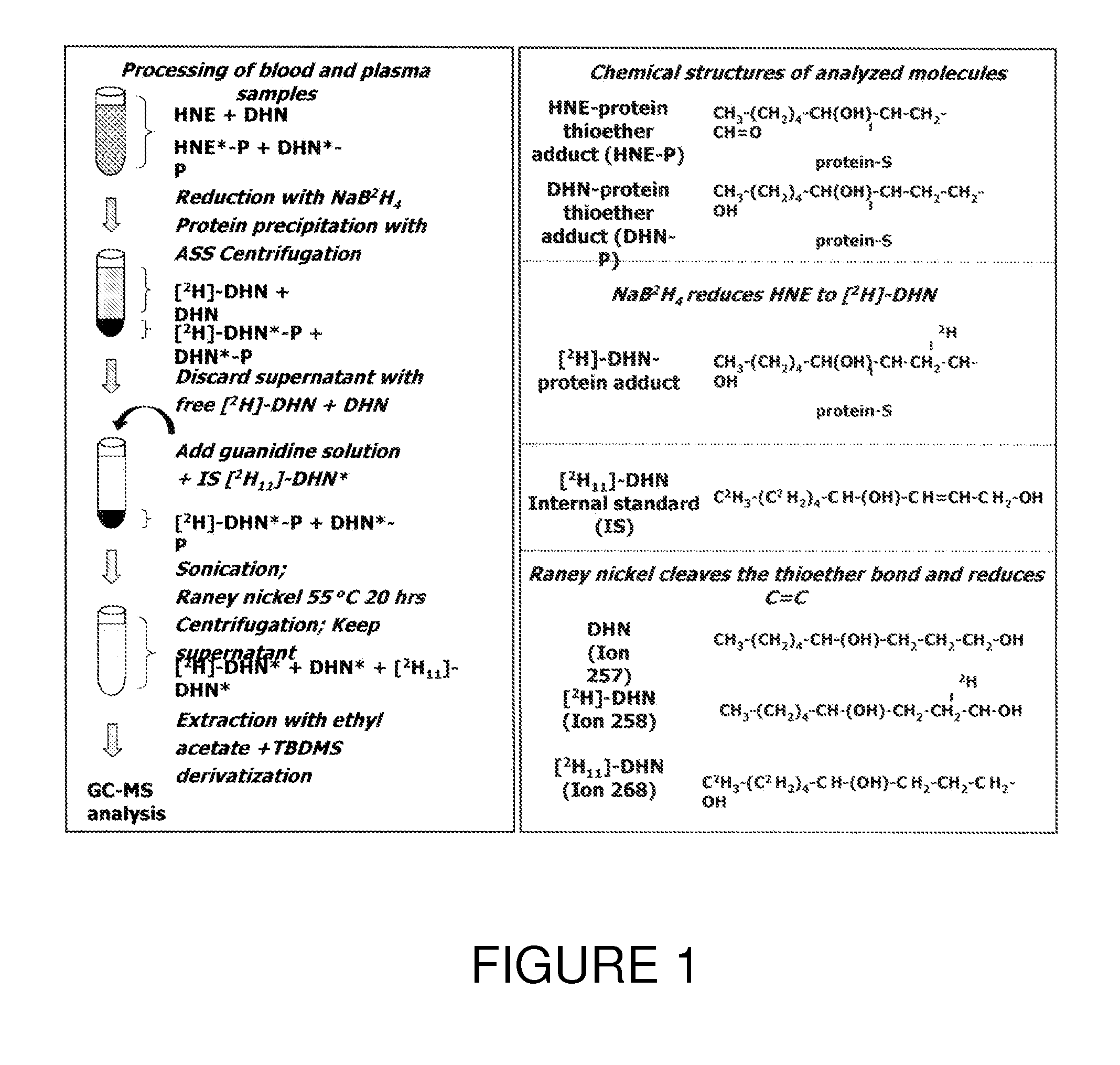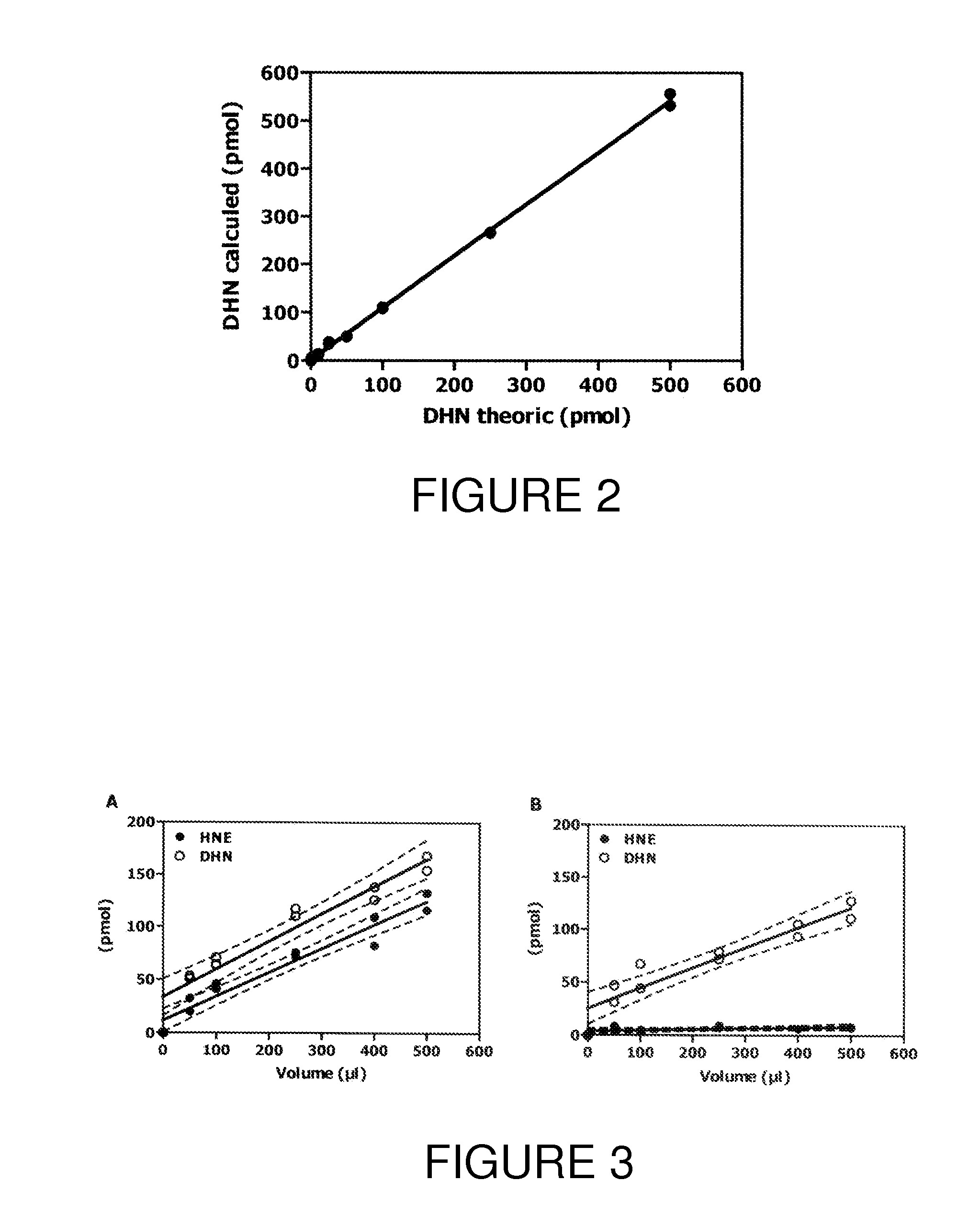Method for quantifying oxidative stress caused by different biological pathways
a biological pathway and oxidative stress technology, applied in the field of methods for quantifying oxidative stress caused by different biological pathways, can solve the problems of relatively complex and lengthy processes, and achieve the effect of convenient and quick operation, effective and simple method, and convenient steps
- Summary
- Abstract
- Description
- Claims
- Application Information
AI Technical Summary
Benefits of technology
Problems solved by technology
Method used
Image
Examples
example 1
[0063]An experiment was performed in order to quantify HNE and its inactive metabolite, 1,4-dihydroxynonene (DHN), bound to thiol protein adducts following treatment with NaB2H4 and Raney nickel. Levels of these adducts were measured in blood and plasma collected from SHR and control Wistar rats at 7, 15, 22 and 30 weeks of age. Levels of protein-bound HNE, which were quantitated with relatively good precision in the nanomolar range in blood, but not in plasma, were significantly increased by disease (SHR) and age (p<0.0001 for both). Compared to Wistar rats, SHR showed greater blood levels of HNE-protein adducts at 22 and 30 weeks. Levels of protein-bound DHN, which were detected in blood and in plasma, were not affected by disease or age. Collectively, the results of this study conducted in an animal model of cardiomyopathy demonstrate that changes in blood HNE-protein thioether adducts with disease progression and aging can be assessed with good precision by the described GCMS me...
example 2
[0064]Another experiment was performed to assess the role of 4-hydroxynonenal (HNE) in oxidative-stress related diseases. Further to the finding of high circulating HNE-protein thioether adducts (HNE-P) in spontaneously hypertensive rats (SHR), this study aimed at correlating HNE-P with cardiac function and testing the impact of antioxidant therapy.
[0065]The lipoperoxidation inhibitor Probucol (10 mg / kg / day) or vehicle (corn oil) were administered daily (i.p.) for 4 weeks in 18-week-old SHR (9 rats / group). Cardiac functions were assessed by echocardiography and HNE-P by GCMS.
[0066]Diastolic dysfunction worsened in SHR receiving vehicle as reflected by changes (p<0.05) in indexes of left ventricular relaxation (increased isovolumic relaxation time) and compliance (increased E wave deceleration rate, EDR). Higher circulating HNE-P correlated with diastolic dysfunction (EDR: R2=0.518; p<0.001) and heart rate (R2=0.225; p<0.05). Probucol prevented the deterioration of diastolic function...
example 3
Discussion (Example 3)
[0083]In this study, a GCMS method for relatively precise quantitation of HNE- and DHN-bound to circulating thiol-containing proteins was validated. The method involves stabilisation of HNE through reduction to its deuterated alcohol [2H]DHN, treatment of samples with Raney Nickel, and the use of a deuterated internal standard, [2H11]DHN. The proposed method was characterized for the following parameters: LOD, LOQ, precision, reproducibility, and robustness. As currently described, one technician can process about 80-100 samples per week. The variation between different assays (10-20%) is smaller than that between subjects (30-40%). Further, the precision observed in the LOQ determination compares well with GC / LC-MS assay of plasma isoprostanes [9A] or nitrotyrosine [10A], which are used as markers of oxidative and nitrosative stress, respectively. Moreover, while the stability of LPO-derived products in biological samples has often been considered a major prob...
PUM
| Property | Measurement | Unit |
|---|---|---|
| Fraction | aaaaa | aaaaa |
| Fraction | aaaaa | aaaaa |
| Fraction | aaaaa | aaaaa |
Abstract
Description
Claims
Application Information
 Login to View More
Login to View More - R&D
- Intellectual Property
- Life Sciences
- Materials
- Tech Scout
- Unparalleled Data Quality
- Higher Quality Content
- 60% Fewer Hallucinations
Browse by: Latest US Patents, China's latest patents, Technical Efficacy Thesaurus, Application Domain, Technology Topic, Popular Technical Reports.
© 2025 PatSnap. All rights reserved.Legal|Privacy policy|Modern Slavery Act Transparency Statement|Sitemap|About US| Contact US: help@patsnap.com



